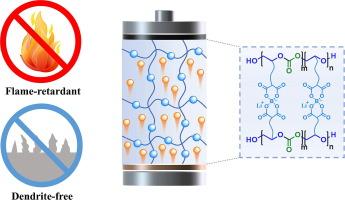Flame-retardant polycarbonate-based single-ion conducting polymer electrolyte for high-safety lithium batteries
IF 14.9
1区 化学
Q1 Energy
引用次数: 0
Abstract
The low lithium transference number of conventional dual-ion polymer electrolytes will lead to concentration polarization and lithium dendrite growth, thereby affecting the safety and cycling performance of lithium batteries. Herein, we report a flame-retardant polycarbonate-based single-ion conducting polymer electrolyte (PAGEC-B/PFN). Due to the immobilization of anions within the polycarbonate cross-linking network, PAGEC-B/PFN exhibits a high lithium transference number (0.86), which is beneficial for alleviating concentration polarization and suppressing the growth of lithium dendrite. With the assistance of the TEP flame retardant and FEC, as well as LiNO3 additives, PAGEC-B/PFN exhibits excellent flame retardancy, high ionic conductivity, and outstanding interfacial compatibility with the lithium metal anode. As expected, PAGEC-B/PFN achieves a high critical current density of up to 2.0 mA cm−2 and stable cycling of Li||Li cell for over 2200 h. Meanwhile, LFP||PAGEC-B/PFN||Li cell delivers a specific capacity of 147.8 mA h g−1 at 0.5 C and exhibits excellent cycling performance over 600 cycles. This work provides a strategy for designing solid-state lithium batteries with high safety and high performance.

高安全性锂电池用阻燃聚碳酸酯基单离子导电聚合物电解质
常规双离子聚合物电解质的锂转移数低,会导致浓度极化和锂枝晶生长,从而影响锂电池的安全性和循环性能。本文报道了一种阻燃聚碳酸酯基单离子导电聚合物电解质(PAGEC-B/PFN)。由于阴离子在聚碳酸酯交联网络内的固定作用,PAGEC-B/PFN表现出较高的锂转移数(0.86),有利于缓解浓度极化和抑制锂枝晶的生长。在TEP阻燃剂和FEC以及LiNO3添加剂的辅助下,PAGEC-B/PFN表现出优异的阻燃性、高离子电导率以及与锂金属阳极良好的界面相容性。正如预期的那样,PAGEC-B/PFN实现了高达2.0 mA cm - 2的高临界电流密度和Li||锂电池超过2200 h的稳定循环。同时,LFP||PAGEC-B/PFN||锂电池在0.5 C下提供了147.8 mA h g - 1的比容量,并在600次循环中表现出优异的循环性能。本工作为设计高安全性、高性能的固态锂电池提供了一种策略。
本文章由计算机程序翻译,如有差异,请以英文原文为准。
求助全文
约1分钟内获得全文
求助全文
来源期刊

Journal of Energy Chemistry
CHEMISTRY, APPLIED-CHEMISTRY, PHYSICAL
CiteScore
19.10
自引率
8.40%
发文量
3631
审稿时长
15 days
期刊介绍:
The Journal of Energy Chemistry, the official publication of Science Press and the Dalian Institute of Chemical Physics, Chinese Academy of Sciences, serves as a platform for reporting creative research and innovative applications in energy chemistry. It mainly reports on creative researches and innovative applications of chemical conversions of fossil energy, carbon dioxide, electrochemical energy and hydrogen energy, as well as the conversions of biomass and solar energy related with chemical issues to promote academic exchanges in the field of energy chemistry and to accelerate the exploration, research and development of energy science and technologies.
This journal focuses on original research papers covering various topics within energy chemistry worldwide, including:
Optimized utilization of fossil energy
Hydrogen energy
Conversion and storage of electrochemical energy
Capture, storage, and chemical conversion of carbon dioxide
Materials and nanotechnologies for energy conversion and storage
Chemistry in biomass conversion
Chemistry in the utilization of solar energy
 求助内容:
求助内容: 应助结果提醒方式:
应助结果提醒方式:


